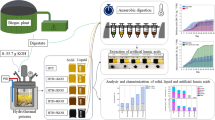Abstract
Hot water and aqueous ammonia fractionation of corn stover were used to separate hemicellulose and lignin and improve enzymatic digestibility of cellulose. A two-stage approach was used: The first stage was designed to recover soluble lignin using aqueous ammonia at low temperature, while the second stage was designed to recover xylan using hot water at high temperature. Specifically, the first stage employed a batch reaction using 15 wt.% ammonia at 60 °C, in a 1:10 solid:liquid ratio for 8 h, while the second stage employed a percolation reaction using hot water, 190–210 °C, at a 20 ml/min flow rate for 10 min. After fractionation, the remaining solids were nearly pure cellulose. The two-stage fractionation process achieved 68% lignin purity with 47% lignin recovery in the first stage, and 78% xylan purity, with 65% xylan recovery in the second stage. Two-stage treatment enhanced the enzymatic hydrolysis of remaining cellulose to 96% with 15 FPU/g of glucan using commercial cellulase enzymes. Enzyme hydrolyses were nearly completed within 12–24 h with the remaining solids fraction.






Similar content being viewed by others
References
Glassner, D.A., Hettenhaus, J.R., Schechinger, T.M. (1998). Conference: BioEnergy '98: Expanding bioenergy partnerships, Madison, WI.
Koukios, E. G., & Valkanas, G. N. (1982). Industrial & Engineering Chemistry Product Research and Development, 21, 309–314.
Henschen, H. (2010). New York, NY: Wall Street Journal (Eastern edition). 24 Apr 2010. B.11.
Langvad, N. (2007). California-Denmark Workshop on Clean Technology, San Francisco, California.
Nghiem, N.P., Donnelly, M., Sanville-Millard, C.Y. (2005). A method to produce succinic acid from raw hydrolysates, WO 2005/116227.
Sanchez, S., Bravo, V., Castro, E. A., Moya, J., & Camacho, F. (1998). Applied Microbiology and Biotechnology, 50, 608–611.
Vazquez, M. J., Alonso, J. L., Dominguez, H., & Parajo, J. C. (2001). Trends in Food Science and Technology, 11, 387–393.
Izumi, Y., Azumi, N., Kido, Y., Nakabo, Y. (2004). Japan Patent, JP 2,004,210,666.
Katapodis, P., Kavarnou, A., Kintzios, S., Pistola, E., Kekos, D., & Macris, B. J. (2002). Biotechnological Letters, 24, 1413–1416.
Katapodis, P., & Christakopoulos, P. (2005). NutraCos, 4, 17–21.
Moure, A., Gullon, P., Dominguez, H., & Parajo, J. C. (2006). Process Biochemistry, 41, 1913–1923.
Yukawa, M., Okuda, S., Ozeki, K. (2005). Japan Patent, JP 2,005,263,722.
Kim, T. H., & Lee, Y. Y. (2005). Applied Biochemistry and Biotechnology, 121–124, 1119–1132.
Kim, T. H., & Lee, Y. Y. (2006). Biores Technol, 97(2), 224–232.
Kim, T. H., & Lee, Y. Y. (2007). Applied Biochemistry and Biotechnology, 136–140, 81–92.
Liu, C., & Wyman, C. E. (2005). Bioresource Technology, 96(18), 1978–1985.
Makishima, S., Mizuno, M., Sato, N., Shinji, K., Suzuki, M., Nozaki, K., et al. (2009). Bioresource Technology, 100(11), 2842–2848.
Sreenath, H. K., Koegel, R. G., Moldes, A. B., Jeffries, T. W., Straub, R. J. (1999), Process Biochemistry. 35, 1-2, 33-41.
NREL (2008). Determination of structural carbohydrates and lignin in biomass. NREL/TP-510-42618, 2008. Golden, CO: National Renewable Energy Laboratory, NREL.
NREL (2008). Enzymatic saccharification of lignocellulosic biomass. NREL/TP-510-42629, 2008. Golden, CO: National Renewable Energy Laboratory, NREL.
NREL (2008). Determination of sugars, byproducts, and degradation products in liquid fractionation process samples. NREL/TP-510-42623, 2008. Golden, CO: National Renewable Energy Laboratory, NREL.
Acknowledgements
We are grateful to Genencor International Inc. for providing cellulase enzymes. We would also like to thank the National Renewable Energy Laboratory (NREL) for supplying the corn stover. This work was supported by Iowa State University and by a grant from Gyeongnam National University of Science and Technology Industry Academic Cooperation Foundation (2008).
Author information
Authors and Affiliations
Corresponding author
Rights and permissions
About this article
Cite this article
Yoo, C.G., Lee, CW. & Kim, T.H. Two-Stage Fractionation of Corn Stover Using Aqueous Ammonia and Hot Water. Appl Biochem Biotechnol 164, 729–740 (2011). https://doi.org/10.1007/s12010-011-9169-3
Received:
Accepted:
Published:
Issue Date:
DOI: https://doi.org/10.1007/s12010-011-9169-3




